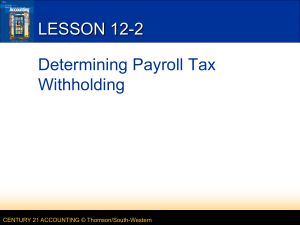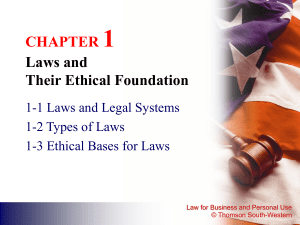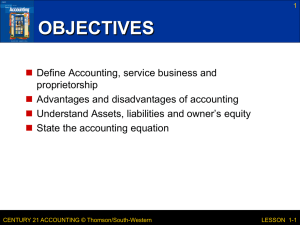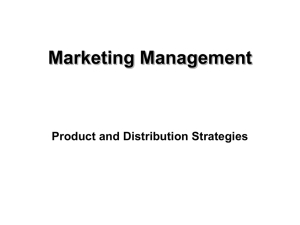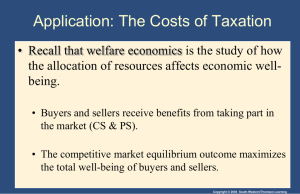Public policy toward public goods
advertisement
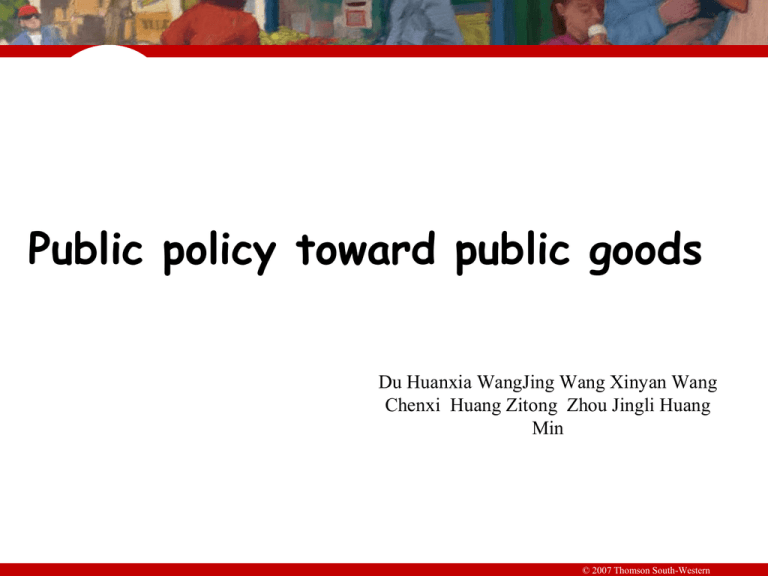
Public policy toward public goods Du Huanxia WangJing Wang Xinyan Wang Chenxi Huang Zitong Zhou Jingli Huang Min © 2007 Thomson South-Western The best things in life are free... © 2007 Thomson South-Western “Free goods provide a special challenge for economic analysis.” © 2007 Thomson South-Western • Most goods in our economy are allocated in markets… 我们经济中的大多数商品是在市场中得到配置 的 • When goods are available free of charge, the market forces that normally allocate resources in our economy are absent. • 当产品可以免费获得时,我们经济中通常配置资 源的市场力量就缺失了。 • When a good does not have a price attached to it, private markets cannot ensure that the good is produced and consumed in the proper amounts. • 当某一产品不具有附加其上的价格时,私有市场 就不能确保以适宜的数量被生产和消费。 © 2007 Thomson South-Western Lead to ... • In such cases, government policy can potentially remedy the market failure that results, and raise economic well-being. • 在这样的情况下,政府政策有可能修复已经产生 的市场失灵,并提高经济福利水平。 © 2007 Thomson South-Western Content Different Kinds of Goods Public Goods Provision News Analysis and Case Study Public-Policy Analysis © 2007 Thomson South-Western THE DIFFERENT KINDS OF GOODS 产品的不同种类 • When thinking about the various goods in the economy, it is useful to group them according to two characteristics: • 在思考经济中不同种类的商品时,根据两种特点 来区分它们是有益的: • Is the good excludable? 该产品是否具有排他性? • Is the good rival?该产品是否具有竞争性? © 2007 Thomson South-Western THE DIFFERENT KINDS OF GOODS 产品的不同种类 • Excludability 排他性 – refers to the property of a good whereby a person can be prevented from using it. – 是指某一产品所具有排除他人使用的属性 • Rivalry in consumption 消费的竞争性 – refers to the property of a good whereby one person’s use diminishes other people’s use. – 是指某一产品所具有的某人使用后会减少他人使用的 属性 © 2007 Thomson South-Western THE DIFFERENT KINDS OF GOODS 产品的不同种类 • Four Types of Goods 四种产品类型 – Private Goods 私人产品 • Goods that are both excludable and rival in consumption • 既具有排他性又有消费竞争性的产品 – Public Goods 公共产品 • Goods that are neither excludable nor rival in consumption © 2007 Thomson South-Western THE DIFFERENT KINDS OF GOODS 产品的不同种类 – Four Types of Goods 四种产品类型 • • • • • • Common Resources 公共资源 Goods that are rival in consumption but not excludable 在消费中具有竞争性但不具有排他性的产品 Natural Monopolies 自然垄断 Goods that are excludable but not rival in consumption 在消费中具有排他性但不具有竞争性的产品 © 2007 Thomson South-Western Figure 1 Four Types of Goods 图1:产品的四种类型 Rival? Yes Yes No Private Goods Natural Monopolies • Ice-cream cones • Clothing • Congested toll roads • Fire protection • Cable TV • Uncongested toll roads Common Resources Public Goods • Fish in the ocean • The environment • Congested nontoll roads • Tornado siren 防空警报 • National defense • Uncongested nontoll roads Excludable? No © 2007 Thomson South-Western Figure 2 Three Types of Public Goods 图2:公共物品的三种类型 公共物品 Public Goods 准公共物品 纯公共物品 quasi—public goods Pure Public Goods 俱乐部物品 共同资源 Club goods Common resources © 2007 Thomson South-Western Public Good Provision 1.private provision There are many historical examples where the rich have financed the provision of public goods: § § § § § § § § § • Music and the Arts were financed by kings and knights. • The rich educated themselves—collected books and preserved knowledge. • The rich can buy expensive early versions of new products, hence generating incentives for R&D oriented towards innovation due to larger monetary incentives. • The Church introduced mechanisms for public goods provision. -Monks, nuns, priests serve as a "public good." -Religious beliefs provided incentives to public good provisions. © 2007 Thomson South-Western 2.Government Provision of Non-Excludable Public Goods Through Taxes. • The government can correct market failure and provide the socially optimal levelof a public good by financing the provision of public goods with tax revenue. Public financing of public goods may be the only option in cases where the public good is non-excludable and, therefore, entry fees cannot be charged (we cover the entry fee case later). • In fact, one could argue that the only role for government in a society is to provide non-excludable public goods such as National Defense and Social Welfare Programs. © 2007 Thomson South-Western 公共物品分类供给 广义公共物品 代表性人物 主导型供给方式 纯公共物品 萨缪尔森 政府供给,联合供给 俱乐部物品 布坎南 联合供给,私人供给 奥斯特罗姆政府供给 政府供给,联合供给,自愿 供给 公共池塘资源 © 2007 Thomson South-Western PUBLIC GOODS 公共产品 § Public goods are goods or services that can be consumed by several individuals simultaneously without diminishing the value of consumption to any one of the individuals. © 2007 Thomson South-Western Some Important Public Goods 某些重要的公共产品 • National Defense 国防 • Basic Research 基础研究 • Fighting Poverty 反贫困 © 2007 Thomson South-Western © 2007 Thomson South-Western Market Failure • Market Failure is a situation in which the market does not provide the ideal or optimal amount of a particular good. • When goods are produced and consumed, side effects occur. These side effects are called externalities because the costs or benefits are external to the person(s) who caused them. © 2007 Thomson South-Western An economic side effect of good or service; it generates benefits or costs to someone other than the person deciding how much to produce or consume. 指一个人或公司的行为不付报酬也不获得报酬地直接影响他人的生活和生产。 Externalities Positive Externalities Negative Externalities © 2007 Thomson South-Western • A Negative Externality exists when a person’s or group’s actions cause an adverse side effect to be felt by others. • A consequence of a negative externality is that social costs do not equal private costs and the socially optimal level of production is not naturally obtained. © 2007 Thomson South-Western The Negative Externality Case • Because of a negative externality, marginal social costs (MSC) are greater than marginal private costs (MPC) and the market output is greater than the socially optimal output. The market is said to fail in that it overproduces the good. © 2007 Thomson South-Western 1.Internalizing Externalities • An Externality is Internalized if the persons or group that generated the externality incorporate into their own private or internal cost-benefit calculations the external benefits (in the case of a positive externality) or the external costs (in the case of a negative externality) that third parties bear. • An externality has been internalized or adjusted for completely if, as a result, the socially optimal output emerges. © 2007 Thomson South-Western 2.Persuasion and Assigning Property Rights • Many negative externalities arise partly because persons or groups do not consider other individuals when they decide to undertake an action. Trying to persuade those who impose external costs on us to adjust their behavior to take these costs into account is one way to make the imposer adjust for – or internalize – externalities. © 2007 Thomson South-Western 3.Taxes and Subsidies • Taxes and subsidies are sometimes used as corrective devices for a market failure. A tax adjusts for a negative externality, a subsidy for a positive externality. • One way to deal with externalities is for government to apply regulations directly to the activities that generate the externalities. Critics of this approach note that regulations are difficult to remove, may be inappropriate in every circumstance and entail costs. © 2007 Thomson South-Western free-rider • A free-rider is a person who receives the benefit of a good but avoids paying for it. • 搭便车是指某人接受某一产品的利益但却避免为 此利益而付费的行为。 © 2007 Thomson South-Western Optimal Provision of a Non-excludable Public Good, The Free-Rider Problem, and Market Failure © 2007 Thomson South-Western • • • • • D1 =Demand of one individual for public good X. D2=Total Demand of two individuals for public good X. D3=Total Demand of three individuals for public good X. D4=Total Demand of four individuals for public good X. D5=Marginal cost of providing the public good X. • The socially optimal level of public good X with four consumers is X4. (Note that the optimal level of the public good with a very large number of individuals ("n"individuals) is Xmax.) Because of non-excludability, markets may fail to provide X4. • Under private markets, each individual may wait for the others to purchase the public good so that he/she can "free-ride." In this case, the private market may provide no public good, because no one is willing to purchase it. For example, if individual 1 decides to purchase (and the others freeride), the private market will provide a level of the public good equal to X1, where the marginal benefit of the purchasing individual equals the marginal cost of providing the public good. © 2007 Thomson South-Western The Free-Rider Problem 搭便车难题 • Since people cannot be excluded from enjoying the benefits of a public good, individuals may withhold paying for the good hoping that others will pay for it. • 由于人们不能被排除使用公共产品的利益,个人 也许会拖延和避免付费,而希望由其他人来支付。 • The free-rider problem prevents private markets from supplying public goods. • 搭便车难题阻止私有市场提供公共产品。 © 2007 Thomson South-Western How to solve it? • Solving the Free-Rider Problem 解决搭便车难题 • The government can decide to provide the public good if the total benefits exceed the costs. • 如果总收益超过总成本,政府可以决定提供公共 产品。 • The government can make everyone better off by providing the public good and paying for it with tax revenue. • 政府可以通过提供公共产品以及用税收收入支付 公共产品的方式,使得大家境况变得更好。 © 2007 Thomson South-Western The Difficult Job of Cost-Benefit Analysis 成本-收益分析的困难工作 • Cost-benefit analysis refers to a study that compares the costs and benefits to society of providing a public good. • 成本—收益分析是指对于社会来说,比较提供公共产品的 成本与收益的研究。 • In order to decide whether to provide a public good or not, the total benefits of all those who use the good must be compared to the costs of providing and maintaining the public good. • 为了决定是否提供某一公共产品,那些使用这些产品的所 有人的总收益必定要与提供和维护该公共产品的成本进行 比较。 © 2007 Thomson South-Western The Difficult Job of Cost-Benefit Analysis 成本-收益分析的困难工作 • A cost-benefit analysis would be used to estimate the total costs and benefits of the project to society as a whole. • 成本—收益分析用来估计社会整体的总成本和总收益。 • It is difficult to do because of the absence of prices needed to estimate social benefits and resource costs.估计社会收益和资 源成本之所以难以做到是因为价格的缺失。 • Without accurate prices, it is difficult to assess attributes like…没有准确的价格,就难以估价以下方面的属性… • the value of life 生活的价值 • the value of consumers’ time, and 消费者时间的价值 • the aesthetics of public good projects. 公共产品项目的美学 价值 © 2007 Thomson South-Western COMMON RESOURCES 公共资源 • Common resources, like public goods, are not excludable. They are available free of charge to anyone who wishes to use them.公共资源,如同公 共产品,是非排他性的,它们对于希望使用的任 何人来说都是可以免费获得的。 • Common resources are rival goods because one person’s use of the common resource reduces other people’s use. • 公共资源是竞争性产品,因为某人对公共资源的 使用会减少其他人的使用。 © 2007 Thomson South-Western Tragedy of the Commons 公地的悲剧 • The Tragedy of the Commons is a parable that illustrates why common resources get used more than is desirable from the standpoint of society as a whole. • “公地的悲剧”是一个寓言,它从社会整体的立场上描绘 了为什么公共资源的使用超越了合意的水平。 • Common resources tend to be used excessively when individuals are not charged for their usage. • 当个人不需要因自己的使用而付费时,公共资源就倾向 于被过度使用。 • This is similar to a negative externality. • 这与负的外部性相类似 © 2007 Thomson South-Western Some Important Common Resources 某些重要的公共资源 • • • • Clean air and water 清洁的空气和水源 Congested roads 拥挤的道路 Fish, whales, and other wildlife 鱼儿\鲸鱼和其他野生动物 © 2007 Thomson South-Western IN THE NEWS: A Solution to City Congestion 新闻摘录: 对城市拥堵的解决办法 • Motorists driving into central London on weekdays between 7:00 A.M. and 6:30 P.M. pay a daily tax of about $9.50.周一 到周五在早上7点到下午6点半之间进入伦敦市中心的机动 车驾驶员每天支付大约$9.50的税费。 • Cameras record license plate numbers and nonpayers are charged stiff penalties.摄像头记录汽车牌照号码,没有付费 的人将会受到处罚。 • Congestion in central London has decreased by 30%. • 伦敦市中心的拥堵程度由此下降了30%。 • 50,000 fewer cars enter the eight square mile “restricted area” each day. • 每天进入8平方英里的“被限制地区”的车辆减少了5万辆。 © 2007 Thomson South-Western CASE STUDY: Why the Cow Is Not Extinct 案例研究:为什么奶牛没有灭绝? • What will protect me? 是什么保护了我? Private Ownership and the Profit Motive! 私有产权与利润动机 © 2007 Thomson South-Western IN THE NEWS: Should Yellowstone Charge as Much as Disney World? 新闻摘录:黄石公园应当与迪斯尼乐园收费一样多吗? • • • • • • • • • • National parks can be viewed as either public goods or common resources. 国家公园可以被看作既是公共产品,又是公共资源。 If park congestion is light, visits are not rival in consumption. 如果公园拥堵较轻,那么到此游览就不具有消费竞争性。 As congestion increases, park entrance fees could be raised. The likely increase in revenues…随着拥堵增加,公园的门票可能会提 高 could be used to improve national parks, and 可以用来改善国家公园的设施 would encourage others to develop new parks. 将鼓励其他人开发新的公园 © 2007 Thomson South-Western CASE STUDY: Are Lighthouses PublicGoods? 案例研究: 灯塔是公共产品吗? © 2007 Thomson South-Western Case Analysis • Benefit is neither excludable nor rival in consumption for ship captains 灯塔为船长提供的利益既无排他性又无竞争性 • Because of free-rider problem, private markets generally don’t provide lighthouses因为搭便车难题, • 市场通常不提供灯塔 • 19th century England, lighthouse owners charged local port • If port didn’t pay, light turned off • Ships avoided that port © 2007 Thomson South-Western Who is responsable to bulid Lighthouses? © 2007 Thomson South-Western Alternatives analysis • Server A • (1)Government fee is reasonable for settling in-coordination problems in games of public goods finance 政府收费由于解决了公共物品融资博弈中的不合作难题, 因而具有存在的合理性 • (2)Wasting of resources 资源浪费 © 2007 Thomson South-Western • Server B • 一是参与灯塔建造的渔民们有权强迫不肯合作的 人离开这个岛屿; • force the people who refuse to cooperate to leave • 二是这个岛上没有不予合作的人存在。 • all the people are willing to cooperate © 2007 Thomson South-Western • • • • Server C difficult to charge is not technologically feasible high cost © 2007 Thomson South-Western CONCLUSION: THE IMPORTANCE OF PROPERTY RIGHTS 结论: 产权的重要性 • The market fails to allocate resources efficiently when property rights are not well-established (i.e. some item of value does not have an owner with the legal authority to control it). • 当产权没有得到很好的建立(即某些价值项目并不具有 以合法权威予以控制的所有者)时,市场就不能有效地 配置资源。 • When the absence of property rights causes a market failure, the government can potentially solve the problem. • 当产权缺失引起市场失灵时,政府有可能解决这一难题。 © 2007 Thomson South-Western Case Study • Traffic policy of Wuhan city on road congestion • 武汉市针对道路交通 拥堵的政策 © 2007 Thomson South-Western Three aspects of Wuhan city traffic policy • • • • • • The construction of transport infrastructure 交通设施的建设 The management of the non-motor vehicles 对非机动车的管理 The management of motor vehicles 对机动车的管理 © 2007 Thomson South-Western The construction of transport infrastructure • Research institute of Wuhan city traffic development strategy • 武汉市交通发展战略研究院 • There will be more than 20 CRC lines until 2049 • 到2049年武汉市将有20余条轨道交通线路 © 2007 Thomson South-Western © 2007 Thomson South-Western © 2007 Thomson South-Western The management of the non-motor vehicles • Wuhan Traffic Management Bureau • 武汉市公安局交通管理局 • Notice on strengthening the management of the electric bicycle • 关于加强电动车管理的通告 © 2007 Thomson South-Western The management of motor vehicles • Wuhan Traffic Management Bureau • 武汉市公安局交通管理局 • Notice on the management during the maintenance of the second Yangtze River Bridge in Wuhan • 关于长江二桥维修施工期间交通管理的通告 © 2007 Thomson South-Western • The impact of these policies on road traffic congestion 这些政策对道路交通拥堵的影响 • The construction of CRC lines dominated by the government which increases the road supply efficiently • 由政府主导的轨道交通的建设,有效增加道路交通供给 • Registration management of electric bicycle will weaken the negative externality for road traffic congestion • 电动车上牌管理,削弱非机动车对道路交通拥堵的负的外 部效应 • Reasonable division on wayleave of motor vehicles will weaken the negative externality for road traffic congestion • 将机动车通行权合理划分,削弱机动车在道路维护期间负 的外部效应 © 2007 Thomson South-Western Case Analysis Hubei formulated water Pollution Control Ordinance, to encourage emissions trading © 2007 Thomson South-Western The influence of public policy towards public goods • Formulate taxes to correct the effects of a negative externality. • Reduce sewage emissions through emissions trading. • Punish the enterprises which poured sewage excessively to protect water quality. © 2007 Thomson South-Western CONCLUSION: THE IMPORTANCE OF PROPERTY RIGHTS 结论: 产权的重要性 • The market fails to allocate resources efficiently when property rights are not well-established (i.e. some item of value does not have an owner with the legal authority to control it). • 当产权没有得到很好的建立(即某些价值项目并不具有 以合法权威予以控制的所有者)时,市场就不能有效地 配置资源。 • When the absence of property rights causes a market failure, the government can potentially solve the problem. • 当产权缺失引起市场失灵时,政府有可能解决这一难题。 © 2007 Thomson South-Western Summry • Goods differ in whether they are excludable and whether they are rival. 产品在是否具有排他性或者竞争性方面有所不同 • A good is excludable if it is possible to prevent someone from using it. 如果某一产品有可能排除某人使用,那么它就是具有排他 性的。 • A good is rival if one person’s enjoyment of the good prevents other people from enjoying the same unit of the good. 如果某人对该产品的享用阻止其他人享用该产品的相同单 位,那么该产品就是具有竞争性的。 © 2007 Thomson South-Western • Public goods are neither rival nor excludable. • 公共产品既不是竞争性的,也不是排他性的。 • Because people are not charged for their use of public goods, they have an incentive to free ride when the good is provided privately. • 因为人们不会因为他们使用公共产品而付费,而当该产品 由私人提供时,他们具有搭便车的激励。 • Governments provide public goods, making quantity decisions based upon cost-benefit analysis. • 政府提供公共产品,并在成本—收益分析的基础上做出数 量决策。 © 2007 Thomson South-Western • Common resources are rival but not excludable. • 公共资源是竞争性的,但不是排他性的。 • Because people are not charged for their use of common resources, they tend to use them excessively. • 因为人们不需要为使用公共资源而付费,因此他 们倾向于过度使用这些资源。 • Governments tend to try to limit the use of common resources. • 政府倾向于试图限制使用公共资源。 © 2007 Thomson South-Western Policy Analysis • Market:The tragedy of the commons The prisoner's dilemma • Government:Low efficiency Rent seeking Information asymmetry • Therefore, to solve the problem, there should establish a multi-center pattern of public goods supply(market, government and NGO) © 2007 Thomson South-Western © 2007 Thomson South-Western




